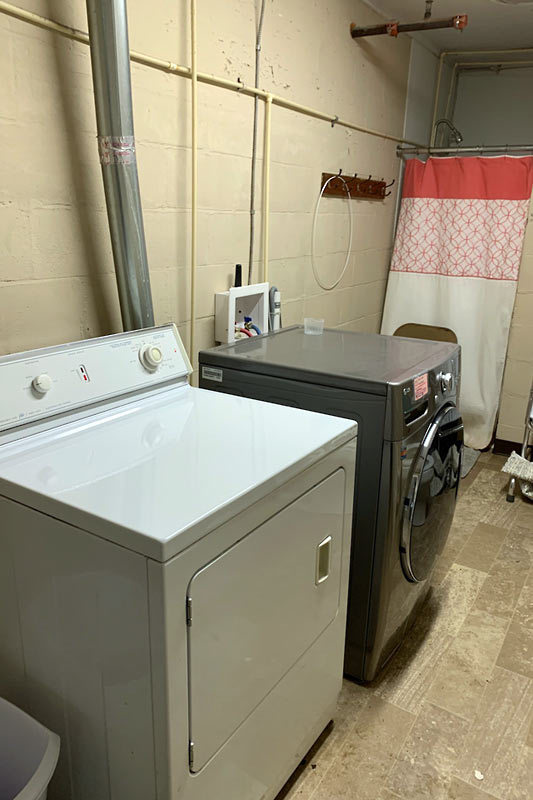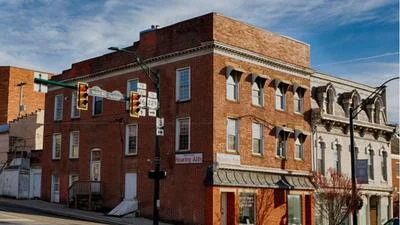Though the Winter Sanctuary is closed to overnight stays through the summer, some services, like the laundry room, pictured above, are available to the homeless.
MOUNT VERNON — While it is “off season” for the Winter Sanctuary Emergency Homeless Shelter, people can still come and utilize other services.
Though the shelter does not provide on-site housing during the summer months, Operations Manager Joe Springer is at the shelter every Tuesday and Thursday from 9 a.m. to 2 p.m. to help people connect with local resources.
On those days, guests can also do laundry and shower at the shelter. Springer said that, as far as he knows, the shelter is the only place in Mount Vernon that lets people do that right now.
The staff and board members, including Knox Public Health Commissioner Julie Miller, are also working on long-term plans for the shelter for COVID-19 safety precautions.
All of this will require community support to achieve, both financially and volunteer-wise.
Even though the weather has warmed up, the need for emergency housing persists. Springer still regularly receives requests from people in need of temporary housing.
The shelter was recently awarded a $25,773 Emergency Food and Shelter grant through United Way; $15,774 of which will cover on-site housing during the winter, while the remaining $10,000 goes toward short-term off-site shelter during the offseason.
Springer said $10,000 seems like a lot, but “when you’re talking about motel stays, that does not last long.”
People who receive short-term shelter are often in a transitional stage — close to finding housing, but need a few days before they can secure it, according to Springer.
Last season, a handful of guests couldn’t find housing in time when the shelter closed early due to COVID-19. A Knox County Foundation grant helped provide motel stays for those guests.
Springer said the shelter is proud that everyone was able to secure housing before the funds ran out and none of them had to end up on the streets. It was especially an achievement given the tightening housing market under COVID-19.
The lack of affordable housing has always been the biggest challenge for the homeless, Springer noted. Many people, even with Metro vouchers or other housing assistance, are nonetheless unable to find open units they can afford, said Springer.
The Knox Metropolitan Housing Authority recently increased its capacity from 674 to 707 vouchers for low-income individuals and households, deputy director Shannon Treisch previously told the News.
However, the waiting list is long — 24 months or longer — with about 250 on the list.
Springer said he always makes sure the shelter’s guests apply to get on the list early.
Homelessness affects people from all walks of life. This past season, Springer noticed an increase of youth — aged 18 and 19 — who were homeless. The reasons for these young people ending up on the streets vary. One was part of a family that was homeless; some had disabilities; some recently aged out of foster care.
According to the National Center for Homeless Education, the number of Ohio public school students who experienced some degree of homelessness during the school year grew from approximately 30,000 in 2017 to 34,000 in 2018.
Springer said that more resources and new funding are coming in for young people experiencing homelessness now.
Homelessness is not only a matter of housing, it also makes seeking gainful employment more difficult due to lack of access to transportation, childcare and technology often needed nowadays to apply for jobs.
Low wages also make it challenging to obtain and retain housing. On average, a minimum wage ($8.55) worker in Ohio needs to work 74 hours a week to afford a 2 bedroom rental home, according to the National Low Income Housing Coalition.
Housing wage refers to the hourly amount renters need to earn to afford a basic two-bedroom apartment. The amount is $15.99 this year, an increase from last year’s $15.73.
In a July 14 press release, the Coalition on Homelessness and Housing in Ohio (COHHIO) reported that the 10 most common jobs in Ohio pay too little for employees to afford a basic two-bedroom apartment. The economic disadvantages could be aggravated by COVID-19.
“People working in common jobs that pay far less than the housing wage — fast food workers, retail salespersons, cashiers, restaurant employees, and janitors and cleaners — are the most likely to have been laid off or lost income as a result of the coronavirus pandemic,” COHHIO noted.
Employment training programs, tenant legal clinic and mental health and substance abuse treatments could help mitigate some of the barriers to stable housing and source of income.
Some of the services have been limited following the outbreak of COVID-19.
Southeastern Ohio Legal Services typically holds legal tenant clinics at Interchurch Social Services during the homeless shelter’s off-season, starting in May. Due to COVID-19, the in-person clinics have been postponed. However, SEOLS is still accepting intake by phone at 833-288-2936.


